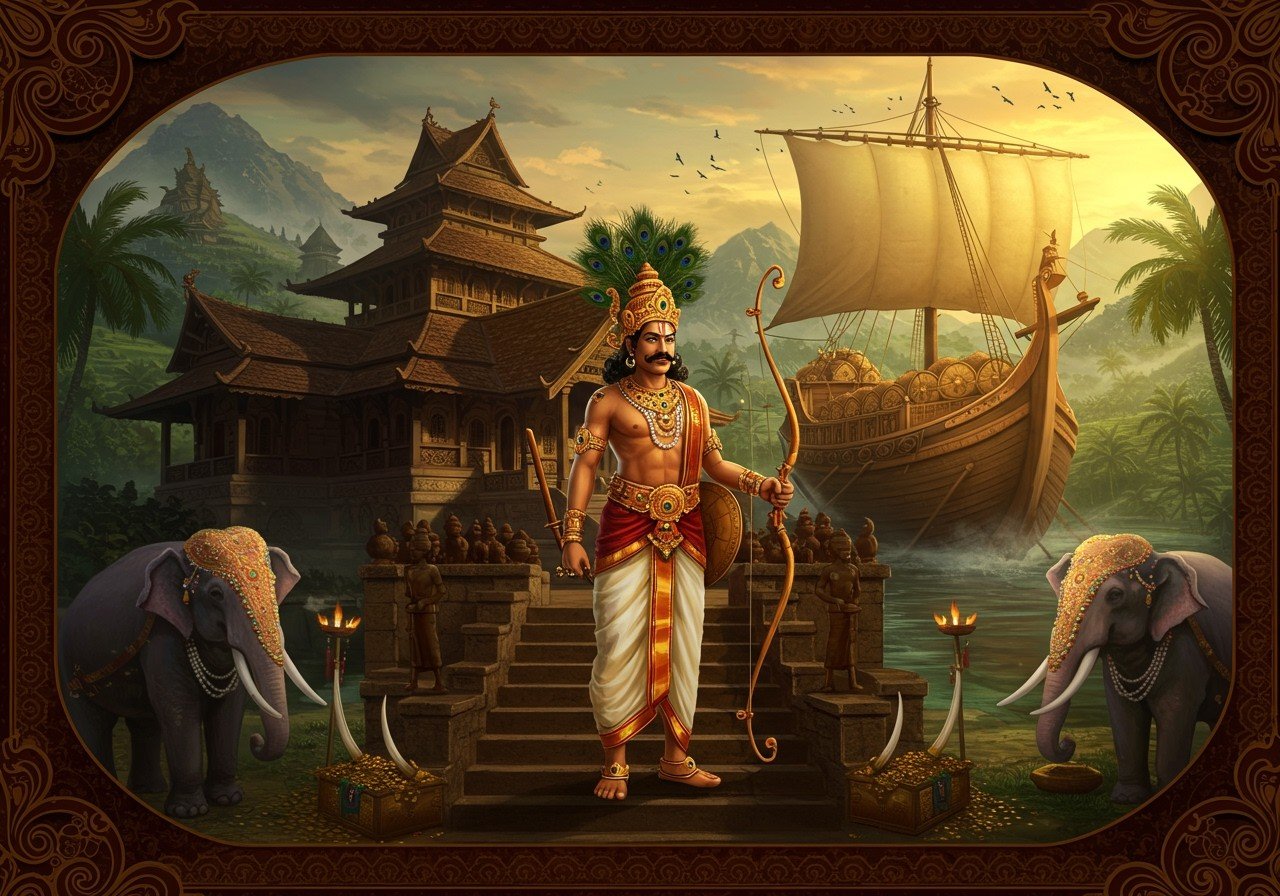
The Chera dynasty, also known as Keralaputra, reigned over parts of modern-day Kerala and Tamil Nadu in southern India during the Sangam period. Alongside the Chola and Pandya dynasties, they constituted one of the three major kingdoms of Tamilakam. This article delves into the lineage of the Chera kings, emphasizing their significant contributions, military conquests, and cultural advancements. Notable rulers include Uthiyan Cheralathan, Nedum Cheralathan, and Kulashekhara Varman. Kings like Cheran Senguttuvan, known for conflicts with the Cholas and Pandyas, and Kadal Pirakottiya Vel Kezhu Kuttuvan, who built the port city of Muziris, further solidified their legacy. The Chera dynasty’s history is preserved through ancient inscriptions and literary works.
Origins and Rise of the Chera Dynasty
The Chera dynasty’s roots lie in ancient Tamilakam, encompassing present-day Kerala and parts of Tamil Nadu. Emerging around the 3rd century BCE, the early rulers established the Chera state. Their emblem, the bow and arrow, symbolizes their martial prowess, a recurring theme in Sangam literature, which chronicles their early exploits.
- Early rulers: These individuals laid the foundation for the Chera state, navigating complex political landscapes and establishing their authority.
- Chera emblem: The bow and arrow, a potent symbol of military strength and kingship, represented the dynasty’s focus on warfare and territorial expansion.
- Sangam literature: This body of work provides valuable insights into the early Chera rulers, their reign, and the socio-political context of the time.
The Cheras forged strategic alliances and engaged in conflicts with neighboring dynasties, including the Cholas and Pandyas. Their strategic geographical location gave them control over vital trade routes and ports, contributing to their economic and political power.
Prominent Rulers of the Chera Dynasty
Several rulers significantly shaped the Chera dynasty’s trajectory.
Uthiyan Cheralathan
Uthiyan Cheralathan solidified the Chera state, establishing a strong foundation for future rulers.
Nedum Cheralathan
Nedum Cheralathan is renowned for expanding the Chera territory, demonstrating military prowess and strategic thinking.
Senguttuvan Chera
Senguttuvan Chera is credited with establishing the worship of goddess Pattini (Kannagi) and leading military expeditions to North India, expanding the kingdom’s influence.
Cheran Senkuttuvan
Cheran Senkuttuvan fostered cultural and religious developments, enriching the kingdom’s heritage and promoting artistic expression.
Kadal Pirakottiya Vel Kezhu Kuttuvan
Kadal Pirakottiya Vel Kezhu Kuttuvan is known for constructing the port city of Muziris, a significant center for trade and commerce, demonstrating the dynasty’s maritime strength.
Later Chera rulers, known as Chera Perumals, played a pivotal role in shaping Kerala’s political and cultural landscape.
Cultural and Economic Contributions
The Chera rulers were patrons of art, literature, and architecture. They actively promoted trade with the Roman Empire, the Middle East, and Southeast Asia, dealing in spices, precious stones, and other valuable commodities.
- Art, literature, architecture: Royal patronage of these fields led to a flourishing of cultural and artistic expression, leaving behind a rich legacy.
- Trade goods: Spices, precious stones, and other valuable items formed the backbone of the Chera economy, facilitating trade with distant lands and contributing to their prosperity.
Grand temples and architectural marvels stand as testaments to their ingenuity. The Cheras also championed religious tolerance, allowing Hinduism, Buddhism, and Jainism to coexist peacefully. Their naval power played a crucial role in maintaining trade dominance and projecting military strength.
Military Conquests and Diplomacy
The Chera rulers employed effective military strategies to defend and expand their territory, engaging in key battles against rival dynasties like the Cholas and Pandyas. Diplomatic relations were vital for maintaining stability, with marriage alliances strengthening ties with neighboring powers.
Battle of Venni
The Battle of Venni represents a significant conflict between the Cheras and the Cholas, highlighting the intense power struggles of the time.
Their strong navy secured maritime trade routes and protected coastal territories, showcasing their maritime prowess.
Conclusion
The Chera dynasty’s legacy is undeniably significant. From their origins in ancient Tamilakam to their cultural and economic contributions, the Chera rulers shaped the historical narrative of South India. Their strategic military conquests, diplomatic alliances, and patronage of art and literature have left an enduring impact on the region’s cultural heritage.
How Poojn.in Connects You to This Rich Heritage
At Poojn.in, India’s largest cultural goods and services store, we offer a wide selection of products that resonate with the rich traditions of South India and the Chera Dynasty’s legacy. Explore our collection of brass and copper puja items, reminiscent of those used in ancient temples, along with traditional lamps, sandalwood products, and pure cotton garments ideal for religious ceremonies.
We offer pure cotton asans, perfect for creating a sacred space for your daily pujas, and hand-crafted idols that bring divine presence into your home. Our pure herbs and powders are ideal for traditional rituals and ceremonies. We also offer a wide selection of books and resources on Indian history and culture, allowing you to delve deeper into the fascinating world of the Chera Dynasty and other significant periods. Visit Poojn.in today and discover a treasure trove of items that honor and preserve India’s rich cultural heritage.
Further explore related topics on our blog:
- Kandariya Mahadeva Temple: Religious Importance and History
- Badami Cave Temples: Chalukya Dynasty Architecture


